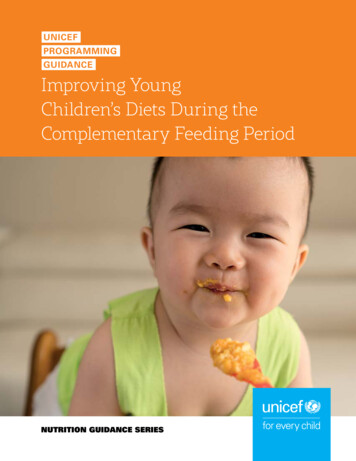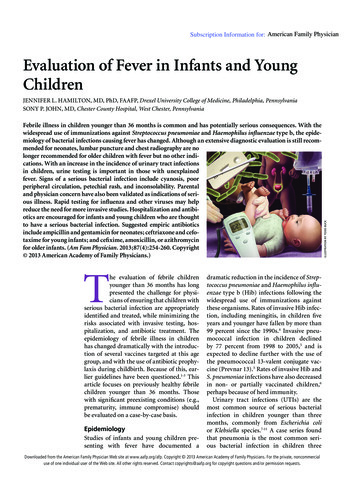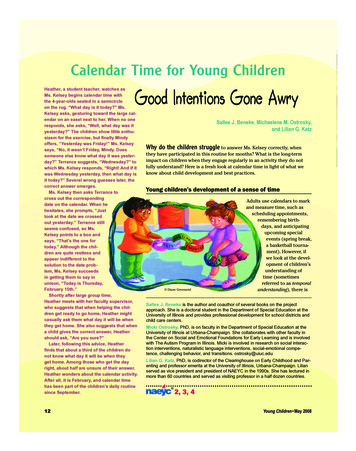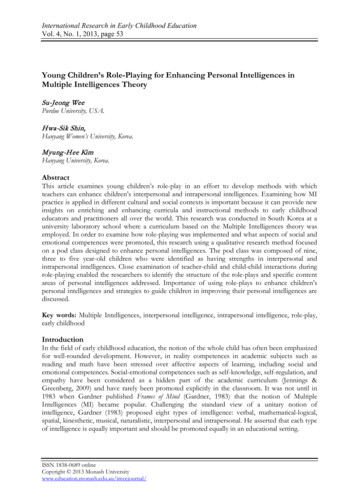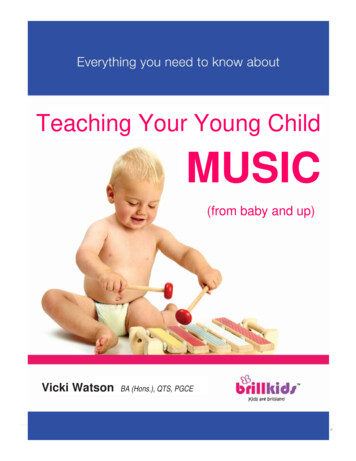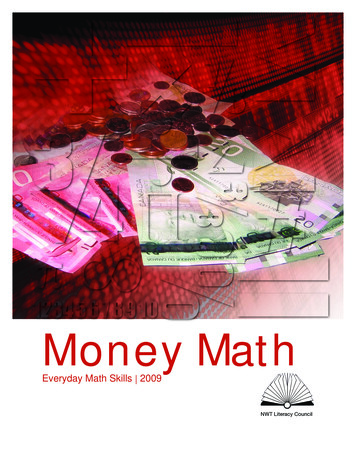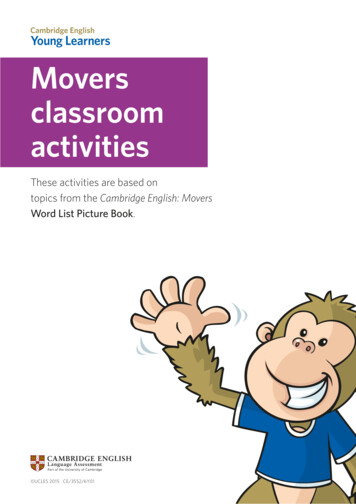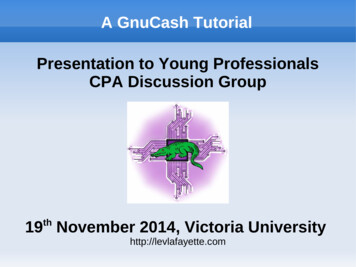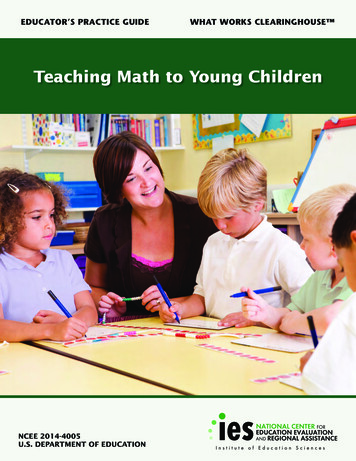
Transcription
EDUCATOR’S PRACTICE GUIDEWHAT WORKS CLEARINGHOUSE Teaching Math to Young ChildrenNCEE 2014-4005U.S. DEPARTMENT OF EDUCATION
The Institute of Education Sciences (IES) publishes practice guides in education to bring the bestavailable evidence and expertise to bear on current challenges in education. Authors of practiceguides combine their expertise with the findings of rigorous research, when available, to developspecific recommendations for addressing these challenges. The authors rate the strength of theresearch evidence supporting each of their recommendations. See Appendix A for a full descriptionof practice guides.The goal of this practice guide is to offer educators specific, evidence-based recommendationsthat address the challenge of teaching early math to children ages 3 to 6. The guide providespractical, clear information on critical topics related to teaching early math and is based on thebest available evidence as judged by the authors.Practice guides published by IES are available on our website at http://whatworks.ed.gov.
IES Practice GuideTeaching Math to Young ChildrenNovember 2013PanelDouglas Frye (Chair)University of PennsylvaniaArthur J. BaroodyUniversity of IllinoisatUrbana-ChampaignandUniversityMargaret BurchinalUniversity of North CarolinaSharon M. CarverCarnegie Mellon University Children’s SchoolNancy C. JordanUniversity of DelawareJudy McDowellSchool District of PhiladelphiaStaffM. C. BradleyElizabeth CavadelJulia LyskawaLibby MakowskyMoira McCulloughBryce OnaranMichael BarnaMathematica Policy ResearchMarc MossAbt AssociatesProject OfficersJoy LesnickDiana McCallumInstitute of Education SciencesNCEE 2014-4005U.S. DEPARTMENT OF EDUCATIONofDenver
This report was prepared for the National Center for Education Evaluation and Regional Assistance,Institute of Education Sciences under Contract ED-IES-13-C-0010 by the What Works Clearinghouse,which is operated by Mathematica Policy Research.DisclaimerThe opinions and positions expressed in this practice guide are those of the authors and do notnecessarily represent the opinions and positions of the Institute of Education Sciences or theU.S. Department of Education. This practice guide should be reviewed and applied according tothe specific needs of the educators and education agency using it, and with full realization thatit represents the judgments of the review panel regarding what constitutes sensible practice,based on the research that was available at the time of publication. This practice guide should beused as a tool to assist in decisionmaking rather than as a “cookbook.” Any references within thedocument to specific education products are illustrative and do not imply endorsement of theseproducts to the exclusion of other products that are not referenced.U.S. Department of EducationArne DuncanSecretaryInstitute of Education SciencesJohn Q. EastonDirectorNational Center for Education Evaluation and Regional AssistanceRuth NeildCommissionerNovember 2013This report is in the public domain. Although permission to reprint this publication is not necessary,the citation should be:Frye, D., Baroody, A. J., Burchinal, M., Carver, S. M., Jordan, N. C., & McDowell, J. (2013). Teaching mathto young children: A practice guide (NCEE 2014-4005). Washington, DC: National Center for EducationEvaluation and Regional Assistance (NCEE), Institute of Education Sciences, U.S. Department of Education. Retrieved from the NCEE website: http://whatworks.ed.govWhat Works Clearinghouse practice guide citations begin with the panel chair, followed by thenames of the panelists listed in alphabetical order.This report is available on the IES website at http://whatworks.ed.gov.Alternate FormatsOn request, this publication can be made available in alternate formats, such as Braille, large print, orCD. For more information, contact the Alternate Format Center at (202) 260-0852 or (202) 260-0818.
Table of ContentsTeaching Math to Young ChildrenTable of ContentsOverview of Recommendations. . . . . . . . . . . . . . . . . . . . . . . .1Acknowledgements . . . . . . . . . . . . . . . . . . . . . . . . . . . . . . 3Institute of Education Sciences Levels of Evidence for Practice Guides. . . . . . .4Introduction to the Teaching Math to Young Children Practice Guide . . . . . . 7Recommendation 1. Teach number and operations using a developmental progression . . 12Recommendation 2. Teach geometry, patterns, measurement, and data analysisusing a developmental progression . . . . . . . . . . . . . . . . . . . . . . . . 25Recommendation 3. Use progress monitoring to ensure that math instructionbuilds on what each child knows . . . . . . . . . . . . . . . . . . . . . . . . . 36Recommendation 4. Teach children to view and describe their world mathematically . . . 42Recommendation 5. Dedicate time each day to teaching math, and integratemath instruction throughout the school day . . . . . . . . . . . . . . . . . . . . 47Glossary . . . . . . . . . . . . . . . . . . . . . . . . . . . . . . . . . . 57Appendix A. Postscript from the Institute of Education Sciences . . . . . . . . . . . . 59Appendix B. About the Authors . . . . . . . . . . . . . . . . . . . . . . . . 61Appendix C. Disclosure of Potential Conflicts of Interest . . . . . . . . . . . . . . . 64Appendix D. Rationale for Evidence Ratings . . . . . . . . . . . . . . . . . . . 65Endnotes . . . . . . . . . . . . . . . . . . . . . . . . . . . . . . . . . 132References . . . . . . . . . . . . . . . . . . . . . . . . . . . . . . . . . 152List of TablesTableTableTableTableTable1. Institute of Education Sciences levels of evidence for practice guides. . .2. Recommendations and corresponding levels of evidence . . . . . . .3. Examples of a specific developmental progression for number knowledge4. Common counting errors . . . . . . . . . . . . . . . . . . .5. Examples of vocabulary words for types of measurement. . . . . . .( iii ). . 5. .11. 13. 19. 32
Table of Contents (continued)Table 6. Using informal representations . . . . . . . . . . . . . . . . . . .Table 7. Linking familiar concepts to formal symbols . . . . . . . . . . . . . .Table 8. Examples of open-ended questions . . . . . . . . . . . . . . . . .Table 9. Integrating math across the curriculum . . . . . . . . . . . . . . . .Table 10. Examples of tools that can be useful in each math content area . . . . . .Table D.1. Summary of studies contributing to the body of evidence, by recommendationTable D.2. Studies of early math curricula that taught number and operationsand contributed to the level of evidence rating. . . . . . . . . . . . . . . . .Table D.3. Studies of comprehensive curricula with an explicit math componentthat taught number and operations and contributed to the level of evidence rating . . .Table D.4. Studies of targeted interventions that taught number and operationsand contributed to the level of evidence rating. . . . . . . . . . . . . . . . .Table D.5. Studies of interventions that taught geometry, patterns, measurement,or data analysis and contributed to the level of evidence rating . . . . . . . . . .Table D.6. Studies of interventions that used a deliberate progress-monitoringprocess and contributed to the level of evidence rating . . . . . . . . . . . . .Table D.7. Studies of interventions that incorporated math communication,math vocabulary, and linking informal knowledge to formal knowledge andcontributed to the level of evidence rating . . . . . . . . . . . . . . . . . .Table D.8. Studies of interventions that included regular math time, incorporatedmath into other aspects of the school day, and used games to reinforce math skillsand contributed to the level of evidence rating. . . . . . . . . . . . . . . . . 43. 44. 45. 51. 52. . 67.72.76.81.94. 104. 112. 121List of Examples.16182229313439404950541. Modeling one-to-one counting with one to three items .2. Sample cardinality chart . . . . . . . . . . . . .3. Sample number list . . . . . . . . . . . . . . .4. Combining and separating shapes . . . . . . . . .5. Moving from simple to complex patterns . . . . . . .6. The repetitive nature of the calendar . . . . . . . .7. An example of a math-rich environment in the e1. The Basic Hiding game . . . . . . . . .2. The Hidden Stars game. . . . . . . . .3. The Concentration: Numerals and Dots game4. The Shapes game . . . . . . . . . . .5. Creating and extending patterns . . . . .6. The Favorites game . . . . . . . . . .7. The flow of progress monitoring . . . . .8. Progress-monitoring checklist . . . . . .9. Linking large groups to small groups . . .10. Snack time . . . . . . . . . . . . .11. The Animal Spots game . . . . . . . .List of FiguresFigureFigureFigureFigureFigureFigureFigure( iv )
Overview of RecommendationsRecommendation 1.Teach number and operations using a developmental progression. First, provide opportunities for children to practice recognizing the total number of objectsin small collections (one to three items) and labeling them with a number word without needingto count them. Next, promote accurate one-to-one counting as a means of identifying the total number of itemsin a collection. Once children can recognize or count collections, provide opportunities for children to use numberwords and counting to compare quantities. Encourage children to label collections with number words and numerals. Once children develop these fundamental number skills, encourage them to solve basic problems.Recommendation 2.Teach geometry, patterns, measurement, and data analysis using a developmental progression. Help children to recognize, name, and compare shapes, and then teach them to combine andseparate shapes. Encourage children to look for and identify patterns, and then teach them to extend, correct,and create patterns. Promote children’s understanding of measurement by teaching them to make direct comparisonsand to use both informal or nonstandard (e.g., the child’s hand or foot) and formal or standard(e.g., a ruler) units and tools. Help children to collect and organize information, and then teach them to represent that information graphically.Recommendation 3.Use progress monitoring to ensure that math instruction builds on what each child knows. Use introductory activities, observations, and assessments to determine each child’s existingmath knowledge, or the level of understanding or skill he or she has reached on a developmental progression. Tailor instruction to each child’s needs, and relate new ideas to his or her existing knowledge. Assess, record, and monitor each child’s progress so that instructional goals and methods canbe adjusted as needed.(1)
Overview of Recommendations(continued)Recommendation 4.Teach children to view and describe their world mathematically. Encourage children to use informal methods to represent math concepts, processes,and solutions. Help children link formal math vocabulary, symbols, and procedures to their informalknowledge or experiences. Use open-ended questions to prompt children to apply their math knowledge. Encourage children to recognize and talk about math in everyday situations.Recommendation 5.Dedicate time each day to teaching math, and integrate math instruction throughout the school day. Plan daily instruction targeting specific math concepts and skills. Embed math in classroom routines and activities. Highlight math within topics of study across the curriculum. Create a math-rich environment where children can recognize and meaningfully apply math. Use games to teach math concepts and skills and to give children practice in applying them.(2)
AcknowledgmentsThe panel appreciates the efforts of M. C. (“Cay”) Bradley, Elizabeth Cavadel, Julia Lyskawa,Libby Makowsky, Moira McCullough, Bryce Onaran, and Michael Barna from Mathematica PolicyResearch, and Marc Moss from Abt Associates, who participated in the panel meetings, describedthe research findings, and drafted the guide. We also thank Scott Cody, Kristin Hallgren, David Hill,Shannon Monahan, and Ellen Kisker for helpful feedback and reviews of earlier versions of the guide.Douglas FryeArthur J. BaroodyMargaret BurchinalSharon M. CarverNancy C. JordanJudy McDowell(3)
Levels of Evidence for Practice GuidesInstitute of Education Sciences Levels of Evidence for Practice GuidesThis section provides information about the role of evidence in Institute of Education Sciences’(IES) What Works Clearinghouse (WWC) practice guides. It describes how practice guide panelsdetermine the level of evidence for each recommendation and explains the criteria for each of thethree levels of evidence (strong evidence, moderate evidence, and minimal evidence).A rating of moderate evidence refers either toevidence from studies that allow strong causalconclusions but cannot be generalized withassurance to the population on which a recommendation is focused (perhaps because thefindings have not been widely replicated) or toevidence from studies that are generalizablebut have some causal ambiguity. It also mightbe that the studies that exist do not specifically examine the outcomes of interest in thepractice guide, although they may be related.The level of evidence assigned to each recommendation in this practice guide represents thepanel’s judgment of the quality of the existingresearch to support a claim that, when thesepractices were implemented in past research,favorable effects were observed on studentoutcomes. After careful review of the studiessupporting each recommendation, panelistsdetermine the level of evidence for eachrecommendation using the criteria in Table 1.The panel first considers the relevance ofindividual stud
math knowledge, or the level of understanding or skill he or she has reached on a develop - mental progression. Tailor instruction to each child’s needs, and relate


